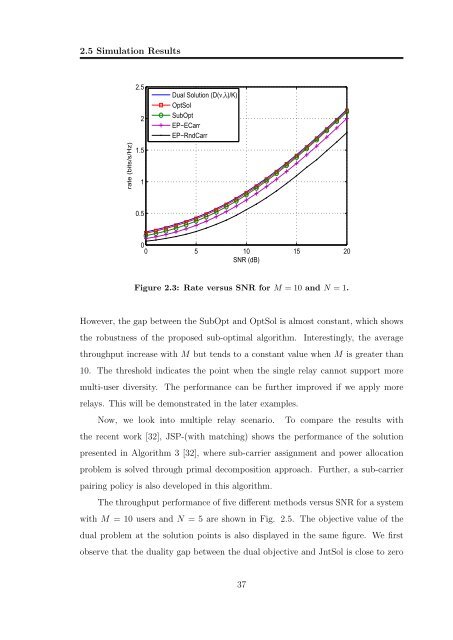Resource Allocation in OFDM Based Wireless Relay Networks ...
Resource Allocation in OFDM Based Wireless Relay Networks ...
Resource Allocation in OFDM Based Wireless Relay Networks ...
You also want an ePaper? Increase the reach of your titles
YUMPU automatically turns print PDFs into web optimized ePapers that Google loves.
2.5 Simulation Results<br />
2.5<br />
2<br />
Dual Solution (D(ν,λ)/K)<br />
OptSol<br />
SubOpt<br />
EP−ECarr<br />
EP−RndCarr<br />
rate (bits/s/Hz)<br />
1.5<br />
1<br />
0.5<br />
0<br />
0 5 10 15 20<br />
SNR (dB)<br />
Figure 2.3: Rate versus SNR for M = 10 and N = 1.<br />
However, the gap between the SubOpt and OptSol is almost constant, which shows<br />
the robustness of the proposed sub-optimal algorithm. Interest<strong>in</strong>gly, the average<br />
throughput <strong>in</strong>crease with M but tends to a constant value when M is greater than<br />
10. The threshold <strong>in</strong>dicates the po<strong>in</strong>t when the s<strong>in</strong>gle relay cannot support more<br />
multi-user diversity. The performance can be further improved if we apply more<br />
relays. This will be demonstrated <strong>in</strong> the later examples.<br />
Now, we look <strong>in</strong>to multiple relay scenario. To compare the results with<br />
the recent work [32], JSP-(with match<strong>in</strong>g) shows the performance of the solution<br />
presented <strong>in</strong> Algorithm 3 [32], where sub-carrier assignment and power allocation<br />
problem is solved through primal decomposition approach. Further, a sub-carrier<br />
pair<strong>in</strong>g policy is also developed <strong>in</strong> this algorithm.<br />
The throughput performance of five different methods versus SNR for a system<br />
with M = 10 users and N = 5 are shown <strong>in</strong> Fig. 2.5. The objective value of the<br />
dual problem at the solution po<strong>in</strong>ts is also displayed <strong>in</strong> the same figure. We first<br />
observe that the duality gap between the dual objective and JntSol is close to zero<br />
37

















